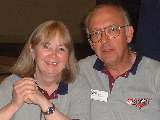Just a Simple Wrench
by Ann & Jake Snyder
 The Best Accessory
The Best Accessory
Of all the coveted extras to have, one of the very most valuable is also the most difficult to get. No, it is not a set of twin SU carburetters to replace the single-throated Zenith-Stromberg, nor air horns, nor a cross-flow head, nor driving lights and not even an overdrive gearbox. It is nothing less than attending one of the Mechanical Seminar hosted by Mr. John H. Twist at University Motors, Ltd. in Ada, Michigan. The reason it is hard to obtain is that you must be there to reap the full benefit of the experience, and the basic course is held only once every February. And the reason attendance at the Mechanical Seminar is so valuable is that you will learn how your MG works and how to keep it working.
Actually, we have taken this course before, and we repeat it whenever there is no other new technical course to take among the February offerings. So far, between us, we have taken the Mechanical Seminar five times. And it has always been different in detail, though not in general scope. Several years ago, we had a choice between chrome and rubber bumper MGBs. We each joined a different group. The choice was harder this year, because there was a late MGB, an MGTF and an MGA. We could not even make an intelligent decision based on color, widely rumored to be as important as any other factor in picking an MG, as all the demonstrator cars were red. Each car had one of the UML staff in attendance wielding the tools. One of us went with the MGB (Tim Wolbert) and the other went with the MGTF (Gregg Purvis). Mr. Twist also had a crowd around the MGA, and we were free to switch groups as we wished. Viewing was best on the MGTF because the car was still in restoration and the wings and bonnet had not yet been fitted.
The session started Friday morning with a tour of the shop, including the gearbox room, the library, the “room of horrors” (very distressed MG parts from customer cars) and a peak at the parts section overseen by Lisa Kenworthy. We did obtain a few parts, some of which could only be obtained here due to the special information that went with them. And we could not pass up the house specialty of red grease, and bought enough to last until next year.
 One of the really big changes that have occurred in the seminar over the years is the large number of visual aids, generally in the form of used MG parts. There was a rear axle carrier and two half shafts, with which Mr. Twist demonstrated how to determine the ring-and-pinion ratio by counting turns with one wheel on the ground: The axle turned 18 times for 38 turns of the pinion flange, giving a ratio of 9/38. A splendid new addition to the visuals is a gearbox with a cut-away case. We learned that Mr. Twist had modified the case himself, cutting the aluminum housing with his Skillsaw.
One of the really big changes that have occurred in the seminar over the years is the large number of visual aids, generally in the form of used MG parts. There was a rear axle carrier and two half shafts, with which Mr. Twist demonstrated how to determine the ring-and-pinion ratio by counting turns with one wheel on the ground: The axle turned 18 times for 38 turns of the pinion flange, giving a ratio of 9/38. A splendid new addition to the visuals is a gearbox with a cut-away case. We learned that Mr. Twist had modified the case himself, cutting the aluminum housing with his Skillsaw.
As each system is explained, the appropriate parts are distributed for inspection. The section on the ignition was very graphic, as Mr. Twist demonstrated all the ways a high-voltage spark can go the wrong place, and we spent as much time crowded around the demonstration table as seated at the tables provided for the lecture.
The Complete Lubrication took almost a day to finish, and the lecturers demonstrated rear oil seal replacement, brake pad replacement, and wheel bearing inspection and lubrication, and spent a long time showing us around under the various MGs. The Compete Tuneup started with a compression check and retorquing the head and setting the valves, after which the compression was checked again. The twin carburetters were set by disconnecting the linkage, setting the air flow so both drew the same amount, setting the mixture, then repeating the air flow and mixture adjustment as necessary.
Checking electrical problems required only a test lamp, jumper wire and wiring diagram. We learned that the capacitor in early SU fuel pumps has been replaced by a diode to control arcing across the points, and polarity is therefore important.
The course comes with a very thick technical manual that is updated every year. The 2002 edition is much thicker (more than 3/4 inch) compared to the one we have from 1995 (an impressive 3/8 inch and 165 pages). “You had to be there” really is appropriate while Mr. Twist tutors on re-establishing proper action of the automatic choke. The photos and text in the manual just do not give the direction of watching him boil the choke in water to set the full-open mark, nor the importance of flattening the mating surface on sand paper. In fact, this whole operation becomes a little clearer every time we see it. Who knows, maybe sometime we will actually have an MG that has an automatic choke, but we have been reluctant to move up to the new 1975 and later models. For those unable to attend the class in person, the manual is available for 35 dollars directly from UML.

Gregg Purvis explaining the difference between leading and trailing shoes
|




